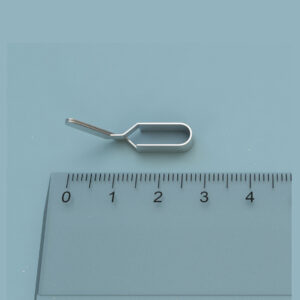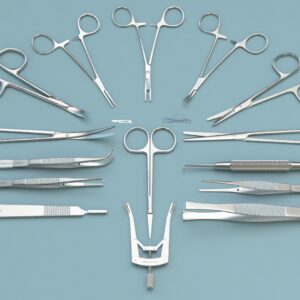$1,990.00
The Judgement Bias Apparatus, utilized by Roelofs S. et al. (2017), is one of two devices employed to evaluate the performance of male and female pigs in spatial holeboard and judgment bias tasks.
This apparatus features a rectangular arena connected to a start box through an antechamber. A guillotine door, operated by a rope and pulley system, controls the pigs’ entry from the start box to the arena.
Reward boxes, where the pigs can find treats, are located at the back wall of the arena near the corners. Each reward box contains a food bowl and can be opened and closed using guillotine doors operated externally via a rope and pulley mechanism.
Mazeengineers supplies the Judgement Bias Apparatus.

MazeEngineers offers custom-built behavioral mazes at no extra cost—designed to fit your exact research needs. Eliminate reproducibility issues from poor sizing or lingering scent cues with precision-engineered, modular, and smart mazes that adapt in real time to animal behavior. Publish new protocols, run adaptive experiments, and push the boundaries of behavioral science.



Features |
Length of rectangular arena: 3.6m |
Width of rectangular arena: 2.4m |
Length of start box: 1.2m |
Width of start box: 1.2m |
Width of goal-box: 40cm |

The Judgement Bias Apparatus is designed to evaluate the affective and emotional states of pigs. Animals’ emotional states can shape their interpretation of stimuli and influence their cognitive processing of various cues (Roelofs, Boleij, Nordquist, van der Staay, 2016). Since animals cannot verbally communicate their feelings, judgement bias testing provides insights into their emotional state and offers an objective measure of cognitive performance.
This apparatus utilizes association-based learning to explore how judgement bias affects decision-making behaviors. It features an open arena with two goal boxes located at the back wall. Pigs learn to associate positive and negative cues with larger and smaller rewards in each goal box. Subsequently, ambiguous stimuli, distinct from the trained reference cues, are introduced. Pigs in a positive affective state are more likely to make optimistic choices regarding the ambiguous stimuli, whereas those in a negative state tend to make pessimistic choices.
The Judgement Bias Apparatus allows for the implementation of various training protocols. Pigs can undergo different treatments to manipulate their emotions and study the resulting effects on judgement. For instance, pigs housed in enriched environments typically exhibit a positive affective state (Douglas, Bateson, Walsh, Bédué, and Edwards, 2012). Understanding pigs’ emotional states is essential for enhancing their welfare, making the Judgement Bias Apparatus a valuable tool in animal welfare research. Additionally, it can aid in developing new therapies for diseases and disorders affecting emotional states, thereby improving the quality of life.
Other apparatuses that utilize association-based learning assays include the Conditioned Place Preference Chamber, the Zebrafish Associative Learning Chamber, the Five Choice Serial Reaction Time Task Chamber, and the Fear Conditioning Chamber.
The judgment bias apparatus features a rectangular arena measuring 3.6 by 2.4 meters. Attached to this arena is a start box with an area of 1.2 square meters, connected via an antechamber. Entry from the start box to the arena is controlled by a guillotine door. Within the arena, goal boxes, each 40 cm wide and containing food bowls, are positioned near the corners along the back wall. These goal boxes also have guillotine doors that can be opened or closed.
Clean the apparatus before and after every trial to prevent the influence of any odor cues from previous trials. Rinse the apparatus if the subject soils it during testing. Appropriately light the apparatus. A tracking and recording system such as the Noldus Ethovision XT can be used to assist with observations.
The following is a sample protocol to observe judgment bias in pigs in response to ambiguous tone cues:
Place the subject into the apparatus and allow it to explore and become familiar with the environment. Following habituation, proceed with forced trials. Place a reward in one of the goal boxes and leave it open. Position the subject in the start box, open the guillotine door, and let the subject enter the arena to retrieve the reward. Once the reward is retrieved, close the goal box and let the subject return to the start box. Perform four sessions consisting of 12 consecutive trials each.
After completing the forced trials, introduce two different tone cues (high and low) to act as positive and negative signals. Associate one tone cue with the larger reward and the other with the smaller reward in the goal boxes. Keep both goal boxes open, but only place the reward in the correct one. Put the subject in the start box and play the corresponding tone cue. Open the door, allowing the subject to enter the arena and seek the reward. Stop the tone cue if the subject chooses the correct goal box and retrieves the reward. If the subject chooses the incorrect goal box, let the tone continue playing until the subject visits the correct goal box and retrieves the reward. Conduct two sessions of 12 trials each, with six trials using the positive tone cue and six with the negative tone cue, in a pseudorandom order. Counterbalance the meanings of the tone cues (positive or negative) and the associated goal boxes across different subjects.
Proceed with open choice trials by placing a reward in the goal box associated with the negative cue and leaving it accessible. Position the subject in the start box and allow it to wait until entry is permitted. Once the subject enters the arena and retrieves the reward, close the goal box and enable its return to the start box. Include two additional trials, one positive and one negative, conducted in a random sequence.
Next, conduct positive and negative free trials. Maintain both goal boxes open and position a reward in the correct goal box. Place the subject in the start box and play the tone cue corresponding to the reward. Open the door, permitting the subject to enter the arena and select a goal box. If the subject chooses incorrectly, enforce a 90-second time-out in the main chamber before allowing it to return to the start box. If the subject fails to choose a goal box within 30 seconds, impose the 90-second time-out penalty. Administer five negative and five positive free trials in a daily-changing pseudorandom order. Continue trials until subjects achieve a learning criterion of at least four correct choices out of five for both positive and negative free trials in three consecutive sessions. Substitute the initial three positive and three negative free trials with open choice trials during every fifth session.
Proceed with conducting Judgement Bias trials following the same protocol as the training trials. However, incorporate three additional ambiguous trials. During these trials, instead of using the positive or negative tone cues, introduce different ambiguous tone cues. Additionally, refrain from placing bait in the goal boxes during these ambiguous trials. Employ ambiguous tone cues such as a nearly negative ambiguous tone, an intermediate ambiguous tone, and a nearly positive ambiguous tone. Conduct a total of 16 trials, with trials 6, 11, and 16 designated as the ambiguous trials.
Roelofs, Nordquist, and van der Staay (2017) explored potential cognitive differences between male and female pigs using the Holeboard apparatus and the Judgement Bias Apparatus. Ten pairs of piglets, housed together in an enriched environment, participated in the study. Initially, the pigs were assessed on the Holeboard apparatus to evaluate their spatial learning and memory abilities. Chocolate candies served as rewards placed in baited holes. Analysis of their visit patterns and revisits to these holes allowed assessment of working memory and reference memory. Results indicated no sex-based differences in working memory or reference memory scores. However, female subjects exhibited a higher total number of hole visits, visited more locations on average, and found more rewards in some trials compared to males.
In the Judgement Bias Apparatus, pigs were trained to associate positive (1000 Hz) and negative (200 Hz) tone cues with either a large (four candies) or small reward (one candy). Discrimination trials followed, where both goal boxes remained open. Incorrect choices or delays exceeding 30 seconds resulted in punishment. Pigs underwent discrimination trials until reaching learning criteria within a maximum of 30 sessions. One female and one male piglet did not meet the criteria among the 20 tested. Among the remaining pigs, no sex differences emerged in the average number of trials needed to meet learning criteria.
During Judgement Bias testing, three ambiguous trials were introduced using tones distinct from learned positive and negative cues: near-negative (299.07 Hz), intermediate (447.21 Hz), and near-positive (668.74 Hz) tones. These trials omitted bait from the goal boxes. Opting for the goal box that would have contained a larger reward during training indicated an optimistic choice. Results indicated that tone type influenced the frequency of optimistic choices, with more observed with the near-positive ambiguous tone. However, repeated testing reduced the number of optimistic choices, with no sex-related differences noted.
Murphy, Nordquist, and van der Staay (2013) conducted a study investigating judgement bias in seven conventional female pigs and eight female Göttingen minipigs using the Judgement Bias Apparatus. Initially, the subjects were trained to associate a positive tone cue with a large reward in one goal box and a negative tone cue with a smaller reward in the other. Following this training, ambiguous tone cues—distinct from the learned positive and negative tones—were introduced, and the selection of the positive or negative goal box was recorded. The ambiguous tones included a near-negative tone, an intermediate tone, and a near-positive tone.
After a four-week hiatus, the testing was repeated. During this phase, subjects were subjected to 15 minutes of confinement in a mini crate before and after trials to induce a negative emotional state. Following a two-week break, testing resumed on the Judgement Bias Apparatus without the confinement procedure. Results indicated that all subjects met the learning criteria within a maximum of 16 sessions. No significant breed-related differences were observed in the frequency of optimistic choices across any of the ambiguous cue types. However, the number of optimistic choices decreased with repeated testing for both breeds.
The following can be observed using the Judgement Bias Apparatus:
The Judgement Bias Apparatus is a versatile tool for examining how the emotional state of pigs influences their decision-making behaviors. It allows for the placement of various rewards into the goal boxes, accommodating experimental flexibility. Additionally, different positive and negative cues can be employed to assess pigs’ responses. Each goal box is equipped with guillotine doors that can be easily operated to control access to rewards as per experimental requirements.
Pigs can undergo diverse treatments aimed at altering their moods, enabling researchers to evaluate the effects of these treatments on their judgement. Furthermore, the Judgement Bias Apparatus plays a crucial role in animal welfare research by enhancing understanding of pigs’ emotional needs and thereby contributing to improving their welfare standards.
Several factors, including age, gender, and strain of the subjects, can influence task performance. The subjects’ exploratory behavior is another variable that can impact task outcomes. Additionally, unintended stimuli may disrupt the subject’s task performance. The training process for subjects on the Judgement Bias Apparatus can require a significant investment of time
There are no questions yet. Be the first to ask a question about this product.
Monday – Friday
9 AM – 5 PM EST
DISCLAIMER: ConductScience and affiliate products are NOT designed for human consumption, testing, or clinical utilization. They are designed for pre-clinical utilization only. Customers purchasing apparatus for the purposes of scientific research or veterinary care affirm adherence to applicable regulatory bodies for the country in which their research or care is conducted.